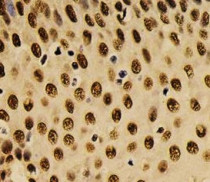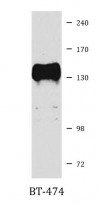ARG57594
anti-TFII-I antibody
anti-TFII-I antibody for IHC-Formalin-fixed paraffin-embedded sections,Western blot and Human,Mouse,Rat
Overview
| Product Description | Rabbit Polyclonal antibody recognizes TFII-I |
|---|---|
| Tested Reactivity | Hu, Ms, Rat |
| Tested Application | IHC-P, WB |
| Host | Rabbit |
| Clonality | Polyclonal |
| Isotype | IgG |
| Target Name | TFII-I |
| Antigen Species | Human |
| Immunogen | Synthetic peptide of Human TFII-I. |
| Conjugation | Un-conjugated |
| Alternate Names | BTKAP1; IB291; TFII-I; WBS; General transcription factor II-I; SRF-Phox1-interacting protein; BAP135; BTK-associated protein 135; Bruton tyrosine kinase-associated protein 135; WBSCR6; BAP-135; Williams-Beuren syndrome chromosomal region 6 protein; GTFII-I; SPIN; DIWS |
Application Instructions
| Application Suggestion |
|
||||||
|---|---|---|---|---|---|---|---|
| Application Note | * The dilutions indicate recommended starting dilutions and the optimal dilutions or concentrations should be determined by the scientist. | ||||||
| Positive Control | BT-474 | ||||||
| Observed Size | 132 kDa |
Properties
| Form | Liquid |
|---|---|
| Purification | Affinity purified. |
| Buffer | PBS (pH 7.3), 0.02% Sodium azide and 50% Glycerol. |
| Preservative | 0.02% Sodium azide |
| Stabilizer | 50% Glycerol |
| Storage Instruction | For continuous use, store undiluted antibody at 2-8°C for up to a week. For long-term storage, aliquot and store at -20°C. Storage in frost free freezers is not recommended. Avoid repeated freeze/thaw cycles. Suggest spin the vial prior to opening. The antibody solution should be gently mixed before use. |
| Note | For laboratory research only, not for drug, diagnostic or other use. |
Bioinformation
| Database Links | |
|---|---|
| Gene Symbol | GTF2I |
| Gene Full Name | general transcription factor IIi |
| Background | This gene encodes a phosphoprotein containing six characteristic repeat motifs. The encoded protein binds to the initiator element (Inr) and E-box element in promoters and functions as a regulator of transcription. This locus, along with several other neighboring genes, is deleted in Williams-Beuren syndrome. There are many closely related genes and pseudogenes for this gene on chromosome 7. This gene also has pseudogenes on chromosomes 9, 13, and 21. Alternatively spliced transcript variants encoding multiple isoforms have been observed. [provided by RefSeq, Jul 2013] |
| Function | Interacts with the basal transcription machinery by coordinating the formation of a multiprotein complex at the C-FOS promoter, and linking specific signal responsive activator complexes. Promotes the formation of stable high-order complexes of SRF and PHOX1 and interacts cooperatively with PHOX1 to promote serum-inducible transcription of a reporter gene deriven by the C-FOS serum response element (SRE). Acts as a coregulator for USF1 by binding independently two promoter elements, a pyrimidine-rich initiator (Inr) and an upstream E-box. Required for the formation of functional ARID3A DNA-binding complexes and for activation of immunoglobulin heavy-chain transcription upon B-lymphocyte activation. [UniProt] |
| Calculated MW | 112 kDa |
| PTM | Transiently phosphorylated on tyrosine residues by BTK in response to B-cell receptor stimulation. Phosphorylation on Tyr-248 and Tyr-398, and perhaps, on Tyr-503 contributes to BTK-mediated transcriptional activation. Sumoylated. [UniProt] |
Images (2) Click the Picture to Zoom In







